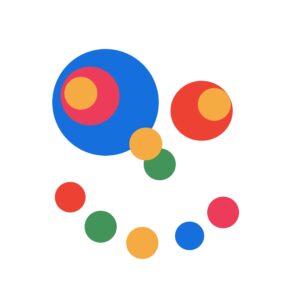Part 1: The Original Obliteration Room and Children's "Play"
The First Obliteration Room and Its Sticker Rules
The Obliteration Room was originally commissioned by the Queensland Art Gallery for the Children’s Art Center (QAGOMA) during the Fourth Asia Pacific Triennial of Contemporary Art (the Queensland Triennial or APT) in 2002. The QAGOMA asked Kusama to create an exhibit for children aged three to twelve years old to accompany her other works featured in the APT: Narcissus Garden (1966/2002) and Soul Under the Moon (2002). Both adults and children were invited to participate in all of her artworks, but The Obliteration Room was created with children in mind, meaning that it was a smaller room with walls that came up to children’s height that parents could see over (Figs. 1&2).[1] It is an installation that invites participants to embellish a white, furnished modern living room with colorful stickers.[2] Visitors to the installation were given a sheet with twenty-eight stickers. In the photographic documentation of this first installation, children can be seen putting these stickers on their faces, unintentionally interacting with the installation in ways that are similar to Kusama’s early Happenings and desire for herself and her audiences to visually become one with her work.
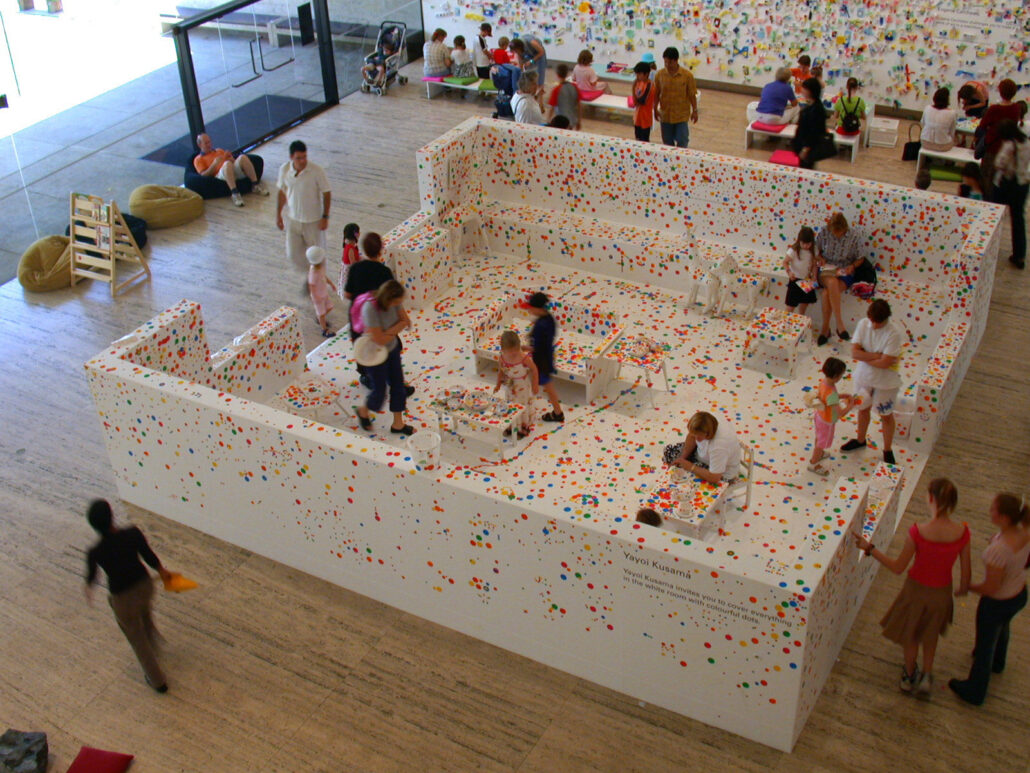
Kids’ APT Interactive Artwork, Gallery 3, QAGOMA.
Collection: Queensland Art Gallery, Brisbane, Australia.
Copyright Queensland Art Gallery, QAGOMA. Imaging Photographer: Natasha Harth.
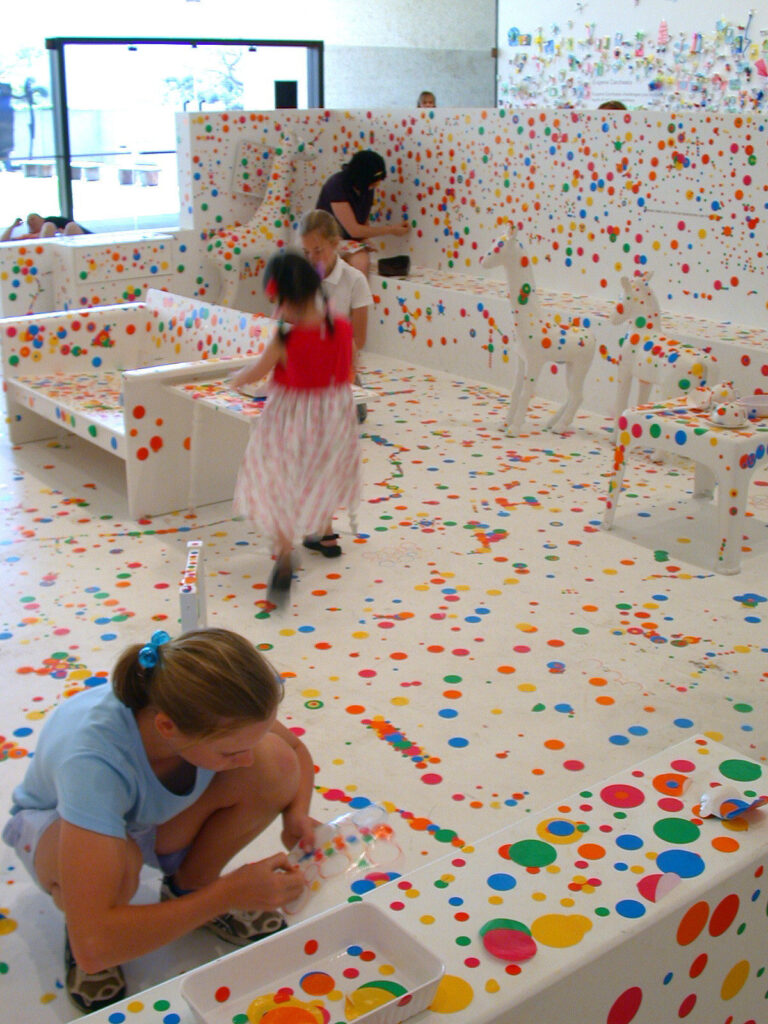
Yayoi Kusama, Kids’ APT Interactive Artwork Gallery 3, QAGOMA.
Copyright: Queensland Art, Gallery. https://www.qagoma.qld.gov.au/copyright-image-reproductions.
QAGOMA, Imaging Photographer: Natasha Harth.
Since the initial Obliteration Room was designed specifically with children in mind, their safety, needs, and wants were taken into consideration. Children are always asked to remain still and not touch or interact with artworks in museums. Kusama invited children to touch and play with artwork in a way that was and is not typically allowed in museum spaces. If anything, the original installation asked adults to interact in a space that is too small and not primarily meant for them. At the same time, the installation would also set up specific rules that would continue to be kept in place with all later versions of The Obliteration Room, even within those that were enclosed and were adult sized. The first installation included monitoring rules that were meant to benefit its younger participants who needed safety through parental monitoring, but those rules were kept and then applied to adults where the monitoring was done by the museum staff and took on a different meaning.
The 2002 iteration was contained by walls that were approximately 5-6 feet high at their tallest with two completely open entrances on either opposing side (Figs. 1&2).[3] The shorter walls acted as a safety measure so that children could always be monitored, but they also extended the interactivity space of the artwork. The entire room, inside, outside, and on the tops of the walls were part of the work and could be stickered.
The work acted as both an installation space and as a sculpture since it was not fully immersive. It could be viewed from the outside, looking over the walls as a structure, but it could also be touched and walked through. Kusama’s name and credit line was plastered on the outside of the walls, indicating that the walls were meant to contain the artwork, however, her name and credits were visibly stickered around and over in the pictures provided by the QAGOMA (Fig. 1). Parents could look over the walls and watch their children play or interact with the room alongside their children. However, if they chose to sit in chairs and on couches, they would be potentially too large to fit comfortably. The small-scale size of the furniture thus emphasizes that the first iteration of the Obliteration Room was meant for children.
The room featured children’s games and toys like three white painted giraffes and multiple tea sets, as well as child-sized furniture that included a small couch and two small tables with chairs (Fig. 2). It also featured a CRT TV, a rotary phone, and large radio, concurrent with the idea that the technology in the room is meant to reflect the year of the work’s installation (Fig. 3). The radio would be removed in later versions and the television would be changed to a more up-to-date flatscreen model, implying that the room changes with the advancement of technology. Kusama’s Obliteration Room is always meant to respond to the current version of modern living room that aligns with the year it is installed rather than to the year it was created.
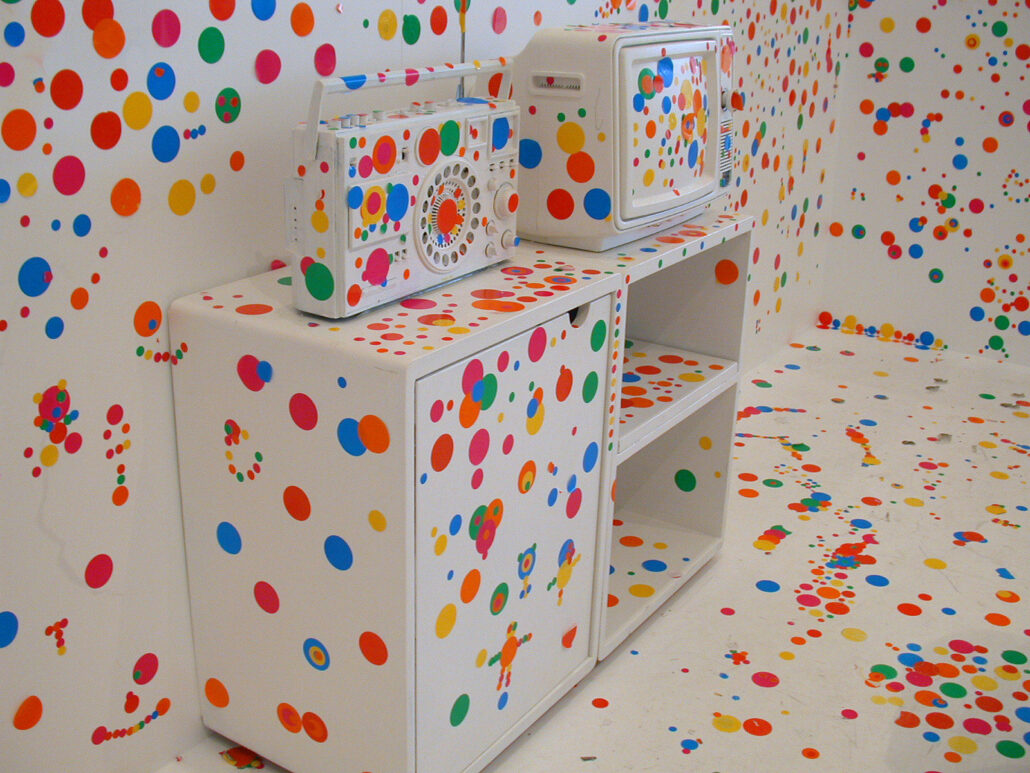

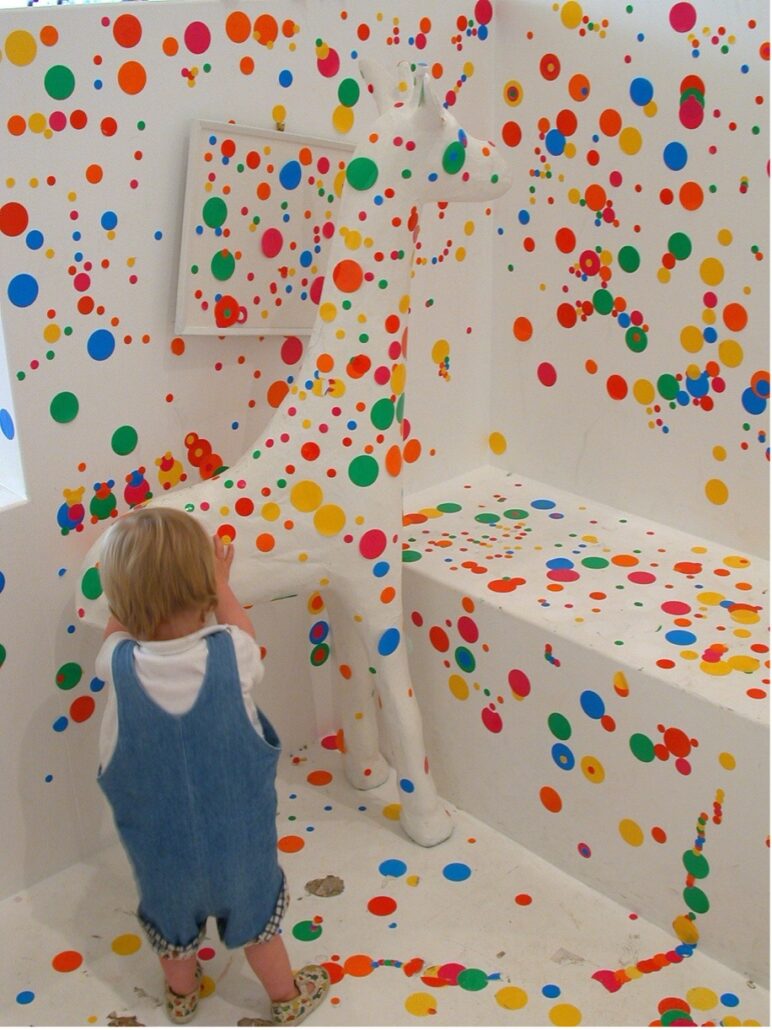

Credit to the Tate Modern and TateShots.
Video still of the sticker sheets from https://www.youtube.com/watch?v=-xNzr-fJHQw&t=43s.
To fulfill the commission for an interactive child’s art piece, Kusama created a preliminary drawing of her expectations for the installation. Kusama’s conceptual drawing for the commission shows a child interacting with a fully immersive space: an all-encompassing environment complete with full-size furnishings, like a dresser, couch, table, lamp, and most importantly —a mirror, allowing the participant to see themselves fully immersed in the work (Fig. 4). Kusama likely chose the participation methodology of dot stickers to appeal specifically to children, who are known to enjoy the quick and colorful interventions that stickers provide. Presumably, for safety reasons, her vision was altered to adhere the APT’s child safety standards, and the resulting room was not all-encompassing. Following the style of her Infinity Rooms first created in 1965 and continuing into the present, Kusama intended for the children to be able to see themselves as inseparable from the art.[4] This point was so crucial to her that the only child she depicted in the conceptual drawing is facing away from the audience, staring at his or her reflection in the mirror. Although not depicted in the drawing, participants would have, most likely, been able to place stickers onto the mirror, fully integrating it into the rest of the space. The inclusion of a mirror was never realized in any iteration of her work, neither the first nor those developed through 2022. However, the rest of her drawing showing the completely engulfing environment and full-sized furniture would be realized in later installations of The Obliteration Room.
In personal correspondence with the author, Jacqueline Tunny, the Program Coordinator for the Children’s Art Centre at the QAGOMA, indicated that the floor, walls, objects, and furniture of all Obliteration Rooms must all be the same shade of white to create a seamless appearance. Items such as a piano, radio, laptop, TV, clock, picture frames, laundry baskets, cutlery, and children’s toys, such as a wooden rocking horse and children’s walker, have been included in past versions of the installation (Fig. 16).[5]
In addition to setting up waiting lines, staff welcomed participants into the installation and informed audience members of the project’s intent. Children were told to “find a special spot for all your stickers on the walls and furniture” and were given one sheet of stickers upon entry into the installation and (supposedly) allowed to place these stickers anywhere in the room.[6]
However, Jacqueline Tunny of the QAGOMA said that patterns would be removed because Kusama had originally forbidden patterning at QAGOMA, insisting that the sticker dots should not be used to make shapes, pictures, or spell out names, which is consistent with the iconic dots in her work that are generated from the obliteration theory. The artist’s rules prohibiting patterning were not disclosed to the children, and the staff were asked to discreetly remove these representational, dotted patterns. Stickers may also be removed for safety reasons, e.g., if they are placed on lights, exit signs, sensors, and water sprinklers.[7]

Credit to Setarra at https://www.setarra.com/yayoi-kusama-infinity-mirrors-hirshhorn-museum-dc.
[1] Queensland Art Gallery, “APT 2002 Asia-Pacific Triennial of Contemporary Art, Brisbane, Australia: Report {APT4 Exhibition Report},” (South Brisbane, QLD, 2002): 48; Queensland Art Gallery, “APT 2002 Asia-Pacific Triennial of Contemporary Art,” 22; Please note that the wall across from the center room structure in figure 1 is a different children’s art piece by Eugene Carchesio and not included as a part of The Obliteration Room.
[2] Mallos, 74; Lynne Seear, APT 2002: Asia-Pacific Triennial of Contemporary Art, (N.p.: Queensland Art Gallery, 2002): 6.
The commissioning body, APT, is held at the QAGOMA every three years with an emphasis on exhibition, film programs, learning initiatives, Children’s Art Centre projects, and a dedicated public program of talks and workshops. APT is supported by the Queensland Government, the Australia Council and the Department of Foreign Affairs and Trade. In 2000, the Queensland Gallery of Modern Art expanded to include the Australian Centre for Asia-Pacific art, a permanent home for all future Triennials.
[3] Tunny, email message, August 4, 2023.
[4] Midori Yamamura, Yayoi Kusama: Inventing the Singular / Midori Yamamura. (Cambridge, Massachusetts: The MIT Press, 2015): 130.
[5] Tunny, email message, August 22, 2023.
[6] Tunny, email message, August 22, 2023; Lillian Gray, “Yayoi Kusama’s Obliteration Room | TateShots,” (Tate Modern, 2012) YouTube. https://www.youtube.com/watch?v=-xNzr-fJHQw&t=43s.
Frances Morris, curator at the Tate Modern, states that visitors are invited to place the stickers “anywhere they like in the room, according to any pattern, any idea they have…anything they like they can do with the stickers.” [0:44].
[7] Tunny, email message, August 22, 2023.
